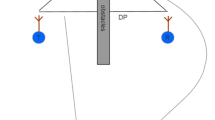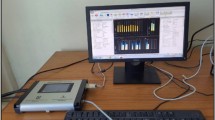Abstract
The identification and mitigation of nonline-of-sight (NLOS) paths play crucial roles in effectively localizing sensor nodes deployed in both indoor and urban outdoor environments. In this work, the NLOS identification and mitigation tasks are performed using the bagging-based ensembled classifier. The proposed method is compared to other state-of-the-art approaches, and promising results, such as higher classification accuracy, are obtained. The received signal waveform is used as raw data, and further statistical features are extracted from the channel impulse response (CIR). The classification performances are analyzed over varying feature subsets, and associated hyperparameters are validated on three datasets. The obtained results strongly suggest implementing the bagging classifier with a proper selection of features and hyperparameters.








Similar content being viewed by others
References
Yin J, Wan Q, Yang S, Ho KC (2016) A simple and accurate tdoa-aoa localization method using two stations. IEEE Sig Process Lett 23(1):144–148
Nguyen NH, Doganay K (2016) Optimal geometry analysis for multistatic TOA localization. IEEE Trans Sig Process 64(16):4180–4193
Wang G, Yang K (2011) A new approach to sensor node localization using rss measurements in wireless sensor networks. IEEE Trans Wirel Commun 10(5):1389–1395
Marano S, Gifford WM, Wymeersch H, Win MZ (2010) Nlos identification and mitigaion for localization based on uwb experimental data. IEEE J Sel Areas Commun 28(7):1026–1035
Ke W, Wu L (2011) Mobile location with nlos identification and mitigation based on modified kalman filtering. Sensors 11(2):1641–1656
Hua J, Yin Y, Lu W, Zhang Y, Li F (2018) Nlos identification and positioning algorithm based on localization residual in wireless sensor networks. Sensors 18(9)
Xiao Z, Wen H, Markham A, Trigoni N, Blunsom P, Frolik J (2013) Identification and mitigation of non-line-of-sight conditions using received signal strength. In: International conference on wireless and mobile computing, networking and communications, pp 667–674
Barral V, Escudero CJ, Garcia-Naya JA, Maneiro-Catoira R (2019) Nlos identification and mitigation using low-cost uwb devices. Sensors 19(16):1–15
Bregar K, Hrovat A, Mohorcic M (2016) Nlos channel detection with multilayer perceptron in low-rate personal area networks for indoor localization accuracy improvement. In: Proceedings of the 8th Joef Stefan international postgraduate school students conference, pp 1–10
Fresno JM, Robles G, Martnez-Tarifa JM, Stewart BG (2017) Survey on the performance of source localization algorithms. Sensors 17(11):1–25
Khodjaev J, Park Y, Malik AS (2010) Survey of nlos identification and error mitigation problems in uwb-based positioning algorithms for dense environments. Ann Telecommun 65(5-6):301–311
Guvenc I, Chong C, Watanabe F (2007) Nlos identification and mitigation for uwb localization systems. In: 2007 IEEE wireless communications and networking conference, pp 1571– 1576
Xiao Z, Wen H, Markham A, Trigoni N, Blunsom P, Frolik J (2014) Non-line-of-sight identification and mitigation using received signal strength. IEEE Trans Wirel Commun 14(3):1689–1702
Destino G, Macagnano D, de Abreu GTF (2007) Hypothesis testing and iterative wlsminimization for wsn localization under los/nlos conditions. In: 2007 conference record of the forty-first asilomar conference on signals, systems and computers, pp 2150–2155
Tian S, Zhao L, Li G (2014) A support vector data description approach to NLOS identification in UWB positioning. Math Probl Eng 2014:1–7
Cheng L, Li Y, Wang Y, Bi Y, Feng L, Xue M (2019) A triple-filter nlos localization algorithm based on fuzzy c-means for wireless sensor networks. Sensors 19(5):1–24
Musa A, Nugraha GD, Han H, Choi D, Seo S, Kim J (2019) A decision tree-based nlos detection method for the uwb indoor location tracking accuracy improvement. Int J Commun Syst 32(13):39–97
Nessa A, Adhikari B, Hussain F, Fernando XN (2020) A survey of machine learning for indoor positioning. IEEE Access 8:214945–214965
Sang CL, Steinhagen B, Homburg JD, Adams M, Hesse M, Rckert U (2020) Identification of nlos and multi-path conditions in uwb localization using machine learning methods. Appl Sci 10(11):1–25
Yang X, Zhao F, Chen T (2018) Nlos identification for uwb localization based on import vector machine. AEU-Int J Electron Commun 87:128–133
Cui Z, Gao Y, Hu J, Tian S, Cheng J (2021) Los/nlos identification for indoor uwb positioning based on morlet wavelet transform and convolutional neural networks. IEEE Commun Lett 25(3):879–882
Park J, Nam S, Choi H, Ko Y, Ko YB (2020) Improving deep learning-based uwb los/nlos identification with transfer learning: An empirical approach. Electronics 9(10):1–13
Chen S, Zhang J, Mao Y, Xu C, Gu Y (2019) Efficient distributed method for nlos cooperative localization in wsns. Sensors 19(5):1–19
Zhang H, Qi X, Wei Q, Liu L (2020) TOA nlos mitigation cooperative localisation algorithm based on topological unit. IET Sig Process 14(10):765–773
Tabaa M, Diou C, El Aroussi M, Chouri B, Dandache A (2013) Los and nlos identification based on uwb stable distribution. In: 2013 25th international conference on microelectronics (ICM), pp 1–4
(2008) Top 10 algorithms in data mining, vol. 14
Dietterich T, Michalski R (1981) Inductive learning of structural descriptions evaluation criteria and comparative review of selected methods
Fernandez-Delgado M, Cernadas E, Barro S, Amorim D, Amorim DF-D (2014) Do we need hundreds of classifiers to solve real world classification problems? J Mach Learn Res 15:3133–3181
Roddick JF, Spiliopoulou M (2002) A survey of temporal knowledge discovery paradigms and methods. IEEE Trans Knowl Data Eng 14(4):750–767
Zhang J, Zhang ZH, Lin Y, Chen N, Gong YJ, Zhong JH, Chung HS, Li Y, Shi YH (2011) Evolutionary computation meets machine learning: A survey. IEEE Comput Intell Mag 6(4):68–75
Zhang ML, Zhou ZH (2014) A review on multi-label learning algorithms. IEEE Trans Knowl Data Eng 26(8):1819–1837
Quinlan JR (1986) Induction of decision trees. Mach Learn 1(1):81–106
Breiman L (2001) Random forests. Mach Learn 45(1):5–32
Moisen GG (2000) Classification and regression trees. Encycl Ecol pp 582–588
Rokach L, Maimon O (2005) Top-Down Induction of Decision Trees Classifiers A Survey. IEEE Trans Syst Man Cybern Part C Appl Rev 35(4):476–487
Safavian SR, Landgrebe D (1991) A survey of decision tree classifier methodology. IEEE Trans Syst Man Cybern 21(3):660–674
Patro RN, Subudhi S, Biswal PK, Acqua FD (2019) Dictionary-based classifiers for exploiting feature sequence information and their application to hyperspectral remotely sensed data. Int J Remote Sens 0(0):1–29
Bermejo P, Gamez JA, Puerta JM (2014) Speeding up incremental wrapper feature subset selection with naive bayes classifier. Knowl-Based Syst 55:140–147
Lv Z, Zhang P, Benediktsson JA (2017) Automatic object-oriented, spectral-spatial feature extraction driven by Tobler’s first law of geography for very high resolution aerial imagery classification. Remote Sens 9(3):1–17
Huang K, Li S, Kang X, Fang L (2016) Spectral spatial hyperspectral image classification based on knn. Sens Imaging 17(1):1–13
Li W, Tramel EW, Prasad S, Fowler JE (2014) Nearest regularized subspace for hyperspectral classification. IEEE Trans Geosci Remote Sens 52(1):477–489
Chawla NV, Bowyer KW, Hall LO, Kegelmeyer WP (2002) Smote: synthetic minority over-sampling technique. J Artif Intell Res 16:321–357
Subudhi S, Patro RN, Biswal PK (2019) Pso-based synthetic minority oversampling technique for classification of reduced hyperspectral image. In: Soft computing for problem solving, pp 617–625
Seiffert C, Khoshgoftaar TM, Van Hulse J, Napolitano A (2009) Rusboost: A hybrid approach to alleviating class imbalance. IEEE Trans Syst Man Cyber Syst Hum 40(1):185–197
Diaz GI, Fokoue-Nkoutche A, Nannicini G, Samulowitz H (2017) An effective algorithm for hyperparameter optimization of neural networks. IBM J Res Dev 61(4/5):9:1–9:11
Yang L, Shami A (2020) On hyperparameter optimization of machine learning algorithms: Theory and practice. Neurocomputing 415:295–316
Acknowledgements
The authors are very much thankful to Prof. Henk Wymseersch and Dr. Tian Shiwe for providing dataset-1, which helped us to validate the classifiers.
Author information
Authors and Affiliations
Corresponding author
Additional information
Publisher’s note
Springer Nature remains neutral with regard to jurisdictional claims in published maps and institutional affiliations.
Rights and permissions
About this article
Cite this article
Rayavarapu, V.C.S.R., Mahapatro, A. NLOS identification and mitigation in UWB positioning with bagging-based ensembled classifiers. Ann. Telecommun. 77, 267–280 (2022). https://doi.org/10.1007/s12243-021-00884-6
Received:
Accepted:
Published:
Issue Date:
DOI: https://doi.org/10.1007/s12243-021-00884-6




